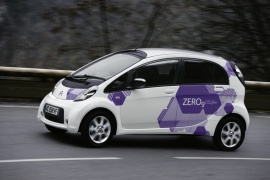CITROEN C-Zero Models/Series Timeline, Specifications & Photos
First production year: 2010
Engines: Electric
Body style: Hatchback
Citroën introduced the C-Zero in 2010 as part of the deal cut with Mitsubishi to develop electric vehicles, and despite not being a successful model, it paved the French automaker’s way to the EV segment.
It took Citroën seventeen years to introduce a second all-electric vehicle after the 1993 AX Electrique. Only this time, it wasn’t just to test the market but to actually make some money out of it. Unfortunately for the French automaker, the car’s price was steep, and Citroën couldn’t find too many customers to pay a price similar to that of a Cadillac CTS or a BMW 3 Series. Furthermore, the charging network was underdeveloped during those times, and the car needed almost 11 hours to replenish its batteries from a regular European power outlet. The C-Zero shared its platform with the Mitsubishi i-MiEV and Peugeot i-On.
The egg-shaped vehicle featured a front fascia that sported a pair of organic-shaped headlights. Since it didn’t need a wide cooling area, there was only a small grille placed on the lower bumper to cool the electronics and the battery pack that was flanked by a pair of round fog lamps. Above it, the automaker made room for the license plate on a black horizontal slat. Between the headlights, on a curved panel, the automaker placed its double-chevron badge.
When Mitsubishi made the i-MiEV, it built it based on the i key-car model, which was available only in Japan. As a result, it had to be shaped to fit into that segment, meaning that the overall dimensions were small but with a tall greenhouse to accommodate four adults inside. The large window area started with a small triangle in front of the doors. Citroën took the same shape and followed the same principles and offered it with body-colored door handles and mirrors. At the back, the almost vertical tailgate was slightly rounded and was flanked by vertical taillights mounted high on the C-pillars.
Inside, the C-Zero featured high-mounted seats so all passengers could have enough legroom and headroom. Behind the rear bench seat, the automaker left room for a tiny trunk that could barely hold a couple of backpacks and a briefcase. Fronting the driver was a small instrument cluster where the speedometer took center stage and was surrounded by an energy consumption gauge. In addition, the automaker placed two additional displays for the battery level and the range. Between the front seats, Citroën installed the gear selector on the center console.
With its rear-mounted motor and the batteries inside the floor, the C-Zero was an excellent vehicle for the urban commute. Its range was close to 130 km (80 miles) in ideal conditions. Still, that was not enough for most customers, who faced difficulties in finding charging stations.
